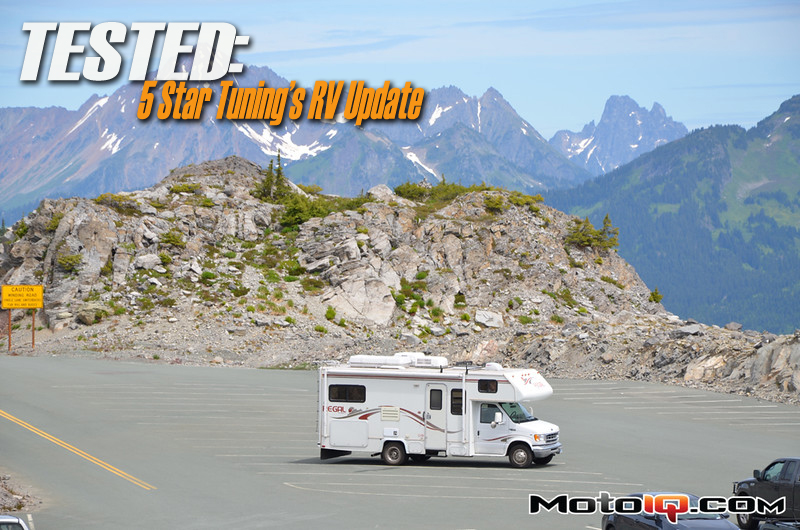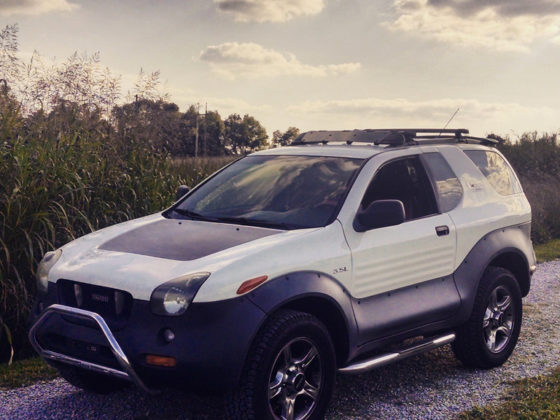,
 Essentially everything on this map is mountain ranges. We drove at elevations of almost sea level to over 5800 feet. As you can see, once in British Columbia we meandered around through the mountains – including a couple of days in Washington where we drove to Artists Point at Mount Baker. Literally the end of the road! From the left side of this map to the right is about 1000 kilometres or 600 miles.
Essentially everything on this map is mountain ranges. We drove at elevations of almost sea level to over 5800 feet. As you can see, once in British Columbia we meandered around through the mountains – including a couple of days in Washington where we drove to Artists Point at Mount Baker. Literally the end of the road! From the left side of this map to the right is about 1000 kilometres or 600 miles.I took 'Arvey (my kids think that's a corny name for an RV) out to my good friend, Elmer, at Platinum Diesel where he graciously fit my gasoline powered RV into his shop for a go over of the brakes and tires. Together we decided that my tires, while they had a ton of tread left on them, were simply too old to tackle the journey through the mountains. The date code indicated that they were almost teenagers, being 12 years old already. Six new Michelin light truck tires were installed in no time. Every time I passed chunks of truck tire on the highway I was pleased with my decision.
 Why do I put Carbotech 1521 brake pads on my RV? Why did I want new tires? Well, this picture explains it perfectly. Just as I want my track car to be as safe and reliable as possible, when I may have my wife and other family members along for the ride in our RV, safety is a priority. I want the best brakes that I can have. Along with the best tires – Michelin in this case – so that I know I will be able to stop when necessary and handle the corners effectively. However, driving the road up and down at Mount Baker, Washington really made me wish I had one of my cars!
Why do I put Carbotech 1521 brake pads on my RV? Why did I want new tires? Well, this picture explains it perfectly. Just as I want my track car to be as safe and reliable as possible, when I may have my wife and other family members along for the ride in our RV, safety is a priority. I want the best brakes that I can have. Along with the best tires – Michelin in this case – so that I know I will be able to stop when necessary and handle the corners effectively. However, driving the road up and down at Mount Baker, Washington really made me wish I had one of my cars!The Carbotech 1521 front brakes and the Ford calipers looked great. We serviced them up and they were good to go. The rear brakes, however, were a different story. I expected the same results as the front but I learned a tough lesson about RVs. As they spend more time sitting than driving, they simply do not get the use that they require. The rear calipers had seized and destroyed both themselves and the pads. This was an unexpected expense but, as we planned to spend a lot of time in the mountains, one that was absolutely required. Time to add annual brake servicing to my RV routine spring prep work.
 The west coast has had a dry, hot summer season. At first glance you may think that the weather is overcast and quite cloudy but that's not the case. Look a bit closer and you'll see a water bomber helicopter dumping it's load. We were literally right next door to a forest fire – more than once.
The west coast has had a dry, hot summer season. At first glance you may think that the weather is overcast and quite cloudy but that's not the case. Look a bit closer and you'll see a water bomber helicopter dumping it's load. We were literally right next door to a forest fire – more than once.I will not bore you with thousands of pictures of scenery, but I will tell you that Northern Ontario is incredible, sunsets on the prairies are super, and the mountains in Alberta and British Columbia are beyond description. We spent a great deal of time in the mountains. This meant that there were days when driving that a 2000 to 5000’ elevation change was simply the norm. That is a challenge for any vehicle.
 Pardon the poor picture quality – I didn't have a tripod with me. Nor was I going to get any closer. I took this photo about 400 metres from where we were camping. The forest fire literally lit up the sky that my photo simply cannot portray. My hat goes off to the men and women who risk their lives fighting forest fires. Unfortunately, many of the fires we heard about could have been avoided. They were started by people – careless with cigarettes, camp fires, and just not caring.
Pardon the poor picture quality – I didn't have a tripod with me. Nor was I going to get any closer. I took this photo about 400 metres from where we were camping. The forest fire literally lit up the sky that my photo simply cannot portray. My hat goes off to the men and women who risk their lives fighting forest fires. Unfortunately, many of the fires we heard about could have been avoided. They were started by people – careless with cigarettes, camp fires, and just not caring. The mountains really made our 15 year old truck work hard and, while the 5 Star tune was designed for 87 octane gas, ours ran more effectively in the mountains with 89 octane. This was not an issue of the tune, but simply a fact of rigorous mountain travel in a vehicle that has a few tired components. We found out that it preferred 89 octane in the mountains when our truck simply quit on a long uphill outside of Kamloops at 5:30 p.m. on a weekend evening. I am going to start keeping track of how often things quit on weekends or right at quitting time. If I had only realized that a major MotoIQ nerd lives in Kamloops, we may have stopped in for the night. I mistakenly thought he lived in a city about three hours away. Fortunately for us, the truck simply needed a 30 minute cool down period and then we continued on our journey. It did throw some engine codes (P1131, P1151, P0171, and P0174), but a thorough check revealed no issues and ongoing mountain excursions illustrated that taking our time and better gas eliminated that issue. Discussing this with 5 Star via email, they pointed out that on an older rig like mine the oxygen sensors or fuel pump may be showing their age. And that is likely true, but since taking it a bit easy and running 89 octane improved things, I have not changed those components yet. Once out of the mountains I switched back to the cheaper 87 octane gasoline. Having a scanner and smart phone allowed me the opportunity to interpret and understand the codes. Valuable tools for any long distance trip.
The mountains really made our 15 year old truck work hard and, while the 5 Star tune was designed for 87 octane gas, ours ran more effectively in the mountains with 89 octane. This was not an issue of the tune, but simply a fact of rigorous mountain travel in a vehicle that has a few tired components. We found out that it preferred 89 octane in the mountains when our truck simply quit on a long uphill outside of Kamloops at 5:30 p.m. on a weekend evening. I am going to start keeping track of how often things quit on weekends or right at quitting time. If I had only realized that a major MotoIQ nerd lives in Kamloops, we may have stopped in for the night. I mistakenly thought he lived in a city about three hours away. Fortunately for us, the truck simply needed a 30 minute cool down period and then we continued on our journey. It did throw some engine codes (P1131, P1151, P0171, and P0174), but a thorough check revealed no issues and ongoing mountain excursions illustrated that taking our time and better gas eliminated that issue. Discussing this with 5 Star via email, they pointed out that on an older rig like mine the oxygen sensors or fuel pump may be showing their age. And that is likely true, but since taking it a bit easy and running 89 octane improved things, I have not changed those components yet. Once out of the mountains I switched back to the cheaper 87 octane gasoline. Having a scanner and smart phone allowed me the opportunity to interpret and understand the codes. Valuable tools for any long distance trip.
 Here we are camping at Chilliwack Lake Provincial Park. It is almost at the end of the road and is a beautiful park on a glacier fed lake. I wasn't about to go swimming. Douglas Fir State Park, just past Glacier, Washington and Glacier National Park, just past Revelstoke, British Columbia – are other parks that I highly recommend. A generator or solar panels is a great way to extend the life of your RV batteries – as many of these parks are rustic and do not have access to services. They offer tons of nature instead!
Here we are camping at Chilliwack Lake Provincial Park. It is almost at the end of the road and is a beautiful park on a glacier fed lake. I wasn't about to go swimming. Douglas Fir State Park, just past Glacier, Washington and Glacier National Park, just past Revelstoke, British Columbia – are other parks that I highly recommend. A generator or solar panels is a great way to extend the life of your RV batteries – as many of these parks are rustic and do not have access to services. They offer tons of nature instead!


